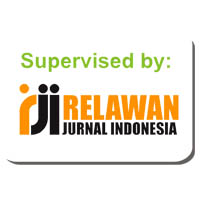IMPLEMENTASI PEMBELAJARAN PENDIDIKAN AGAMA ISLAM (PAI) BERBASIS TEACHER CENTER LEARNING (TCL) DAN STUDENT CENTER LEARNING (SCL) PADA STMIK ANTAR BANGSA
Abstract
Keywords
Full Text:
PDFReferences
Arief, A., & Lubis, F. A. (2020). Inovasi Pendidikan Islam: Teori, Konsep dan Implementasi (1st ed.). Penerbit Deepublish.
Joyce, B., Weil, M., & Calhoun, E. (2009). Model Of Teaching (Model-model Pembelajaran). Pustaka Belajar.
Kurdi, F. N. (2009). Penerapan Student Centered Learning dari Teacher Centered Learning Mata Ajar Ilmu Kesehatan pada Program Studi Penjaskes. Forum Kependidikan, 28(2).
Mariana, M. (2020). Comparation of Teacher Center Learning and Student Center Learning Approach to Better Understanding in Mining Regulation Study. Jurnal Ilmiah PPSDM GEOMINERBA, 5(1).
Panggabean, S., Lisnasari, F. S., Puspitasari, I., & Basuki, L. (2021). Sistem Student Center Learning Dan Teacher Center Learning (A. Munandar, Ed.). Media Sains Indonesia.
Ramadhani, H. S. (2017). EFEKTIVITAS METODE PEMBELAJARAN SCL (STUDENT CENTERED LEARNING) DAN TCL (TEACHER CENTERED LEARNING) PADA MOTIVASI INSTRINSIK & EKSTRINSIK MAHASISWA PSIKOLOGI UNTAG SURABAYA ANGKATAN TAHUN 2014 & 2015. Persona:Jurnal Psikologi Indonesia, 6(2). https://doi.org/10.30996/persona.v6i1.1302
Ramdhani, M. A. (2014). Perbandingan Strategi Pembelajaran Teacher Centered Learning Dengan Student Centered Learning Terhadap Hasil Belajar Pada Mata Pelajaran Tarikh Siswa Kelas Viii Smp Muhammadiyah 4 Surakarta. 2014, 1.
Rianto. (2011). Model-model Pembelajaran Inovatif Berorientasi Konstruktivistik. Prestasi Pustaka. .
Salay, R. (2019). Perbedaan Motivasi Belajar Siswa yang Mendapatkan Teacher Centered Learning (TCL) Dengan Student Centered Learning (SCL). Education, 1(1).
Shoimin, A. (2017). 68 Model Pembelajaran Inovatif dalam Kurikulum 2013 (Rose, Ed.; 2nd ed., Vol. 2). Ar-Ruzz Media.
Silalahi, U. (2012). Metode Penelitian Sosial (A. Gunarsa, Ed.). Refika Aditama.
Sinaga, S. (2020). PROBLEMATIKA PENDIDIKAN AGAMA ISLAM DI SEKOLAH DAN SOLUSINYA. WARAQAT : Jurnal Ilmu-Ilmu Keislaman, 2(1). https://doi.org/10.51590/waraqat.v2i1.51
Sugiyono. (2016). Metode penelitian kuantitatif, kualitatif, dan R&D (23rd ed.). Alfabeta.
Su’ud, S. U. (2015). Inovasi Pendidikan (Riduwan, Ed.; 8th ed.). Alfabeta.
Taniredja, T., Faridli, M. A., & Harmianto, S. (2017). Model-Model Pembelajaran Inovatif dan Efektif (Vol. 7). Alfabeta.
DOI: https://doi.org/10.36671/andragogi.v6i3.1001
Refbacks
- There are currently no refbacks.
Copyright (c) 2025 Tarmizi Tarmizi, Jam'an Nurchotib Mansur

This work is licensed under a Creative Commons Attribution 4.0 International License.

This work is licensed under a Creative Commons Attribution 4.0 International License.





